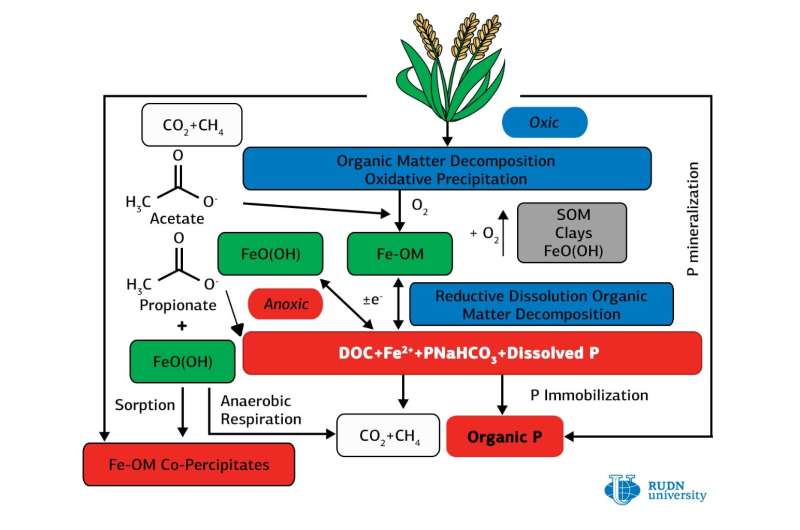Soil scientists increase phosphorus content in paddy soils

Soil scientists from the RUDN University (Russia) and Huazhong Agricultural University (China) have demonstrated that adding carbon compounds to the soil can increase phosphorus availability in paddy fields. For these purposes, biologists have described the processes of iron (III) compounds reduction and phosphorus release by soil microorganisms in the presence of carbon as an energy source. These results will help reduce dependence on phosphate fertilizers and increase agricultural productivity. The research has been published in the journal Geoderma.
Phosphorus deficiency in soils limits crop production capabilities. Often it is found in soils in the form that is unavailable for plants, i.e. iron compounds. Phosphorus unavailability is particularly typical for tropical and subtropical soils, for example, in paddy fields, where iron is one of the most common elements. To resolve this problem, expensive phosphorus fertilizers are used in agriculture. Soil scientists from the RUDN have shown that it is possible to mobilize phosphorus in paddy soils using soil microorganisms. The process requires soil carbon.
Paddy fields are watered to prevent weeds from growing. The depth of watering is periodically changed depending on the phase of plant development. When rice is ripening, water is drained from the fields, and the soil is dried. Therefore, paddy soils have specific properties: They constantly alternate periods of oxidative and reducing processes, when the acidity of such soils increases during stagnation of water and decreases when the water recedes. In addition, a large amount of carbon-rich organic material is accumulated in the upper layer, as well as sedimentary iron due to the destruction of iron-containing rocks affected by water.
Soil microorganisms oxidize or reduce inorganic compounds, transforming them into a different digestible form. In weathered, acidic rice soils, soil microorganisms decompose iron and phosphorus compounds, reducing ferric iron to ferrous, and releasing phosphorus in a form accessible to plants. But this process requires oxygen. Flooded fields with increased soil acidity are prone to oxygen deficiency, which impedes the process of phosphorus release. Scientists have assumed that microorganisms need carbon as an energy source to restore iron without oxygen.
To test this assumption, soil scientists conducted an experiment: They took 255 soil samples from two paddy fields in China with a typical subtropical climate. Researchers removed visible plant debris, stones, and soil microfauna and added oxalate, acetate, propionate, and formiate solutions—labile, that is easily degradable, organic matter that is a readily available carbon source. One sample was left without adding any compound as a control. Soil samples were kept underwater for two months, that is, without oxygen. Paddy soils exist in similar conditions. For 60 days, researchers measured the concentration of ferrous iron in the samples. Iron appears once phosphorus is released and can serve as a marker to find out the concentration of free phosphorus. Direct measurement of phosphorus is more complex and costly.
Measurements showed that labile organic matter accelerated phosphorus release from iron compounds. Moreover, phosphorus is released faster in soil samples with an initially higher concentration of labile organic matter and iron compounds. This proved the assumption that in oxygen-free conditions in paddy soils, carbon can "replace" oxygen as an energy source for soil microorganisms that release phosphorus in the form available for plants.
Research findings show that relatively small amounts of labile organic matter can release soil phosphorus reserves and reduce the dependence of paddy farms on fairly expensive and environmentally unsafe phosphorus fertilizers.
More information: Imran Khan et al. Labile organic matter intensifies phosphorous mobilization in paddy soils by microbial iron (III) reduction (Geoderma, 2019) doi.org/10.1016/j.geoderma.2019.06.011
Provided by RUDN University




















